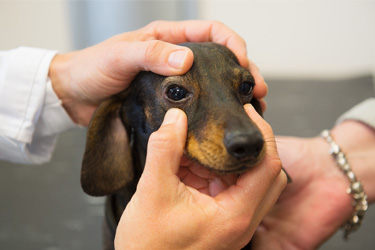Client Info: What’s a Veterinary Ophthalmic Exam?

Do your clients know why and how you perform an ophthalmic exam on their pets? Offer them the information below to ensure they are informed and ready for the exam.
During a routine veterinary check-up, part of the physical examination will focus on the health of the patient’s eyes. To complete a thorough assessment the veterinarian will look not only at the eye, but also at the surrounding tissues.
Veterinary Ophthalmic Examination
When checking on the health of an animal’s eyes, the veterinarian may focus the examination on the following:
Vision
Since a pet can’t read an eye chart, the veterinarian has to watch the animal in order to detect any vision difficulties. This is done by observing:
- The way the animal maneuvers around the room
- How the animal tracks an object that is tossed near their eyes
- The animal’s reaction to a menace test, which checks to see if they blink when a finger is moved toward, but does not touch, the eye.
Pupillary Light Reflex
Testing for pupillary light reflex involves evaluating the following:
- Retina, the sensory membrane that lines the eye
- Iris, the colored part of the eye
- Nerves
- Reaction of the brain to the test.
To perform the pupillary light reflex test, the veterinarian will shine bright light into each eye and watch for the signs that indicate a response of pupil constriction.
Tearing Mechanism
A dog’s eye has two lacrimal glands that function to produce tears. Because a dry or watery eye often indicates a sign of disease, the veterinarian may complete a Schirmer tear test, which involves measuring the volume of tears by:
- Placing a commercial filter paper strip at the inner corner of the eye
- Holding the strip in place for one minute
- Observing how much of the strip is wetted.
The findings will help determine if the animal is producing the amount of tears that are required to keep the eye properly lubricated.
Outer Eye Structures
When evaluating the structures that surround the eyes, the veterinarian will also look for signs of inflammation, infection, cataracts, foreign bodies, and abnormal growths. The examination will look at the:
- Tissues that surround the eyes
- Eyelids
- Tear duct
- Cranial nerves
- Lens of the eye.
Abrasions
A common injury to the eye involves a scratched cornea. Since abrasions and ulcers may be difficult to see with the naked eye, when the signs indicate a corneal injury, the veterinarian may conduct a fluorescein stain test in order to better determine the extent of damage. While this type of injury is painful, the test itself is not.
- A small amount of a lime-green colored dye is dropped into the eye
- The abrasion will absorb the dye
- The extent of the abrasion, its location, and size will instantly be noticeable.
Eye Pressure
Certain breeds and diseases can be linked to eye problems that point to abnormal eye pressure. High eye pressure is a sign of glaucoma, a very serious eye disease that, when left undiagnosed and untreated, can cause blindness. The diagnosis of glaucoma requires the veterinarian to perform a test that measures the animal’s intraocular pressure. The steps involve:
- Coating the eye surface with numbing eye drops
- Tapping the eye surface with a specialized instrument that measures and reads the pressure of the eye.
To the Back of the Eye
To examine the rest of the eye, the veterinarian will first need to dilate the animal’s pupils by placing a few drops of dilating fluid into the eyes and then waiting for the drops to work. Once dilated, the interior of the eye can be examined, including the:
- Retina
- Blood vessels
- Optic nerve
- Fundus
When it comes to a pet’s eyes, one of the most important points to stress to clients focuses on urgency. If at any point, should a pet be observed as having eye pain, eye trouble or vision difficulties, clients should know to contact their veterinarian immediately.
Contact your Covetrus representative for additional information that further explains eye care at: 855.724.3461.
Careers
Are you looking for a place to let your talents shine? At Covetrus, we help our practitioner customers better serve their patients and take pride in providing the best customer experience possible. Search our open positions to see our available opportunities.
Newsletter
Stay current with what’s going on with Covetrus, subscribe to receive our newsletter and email communications. Subscribers will receive the latest information in practice management, sales and marketing, animal health, and more.


Leave a comment